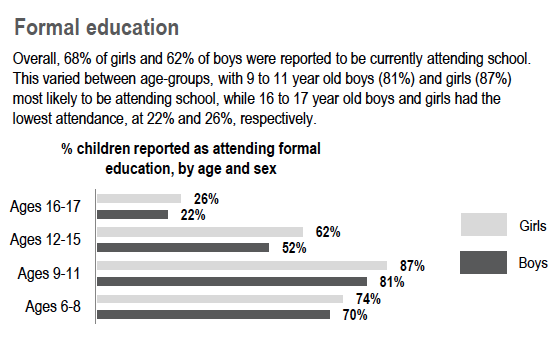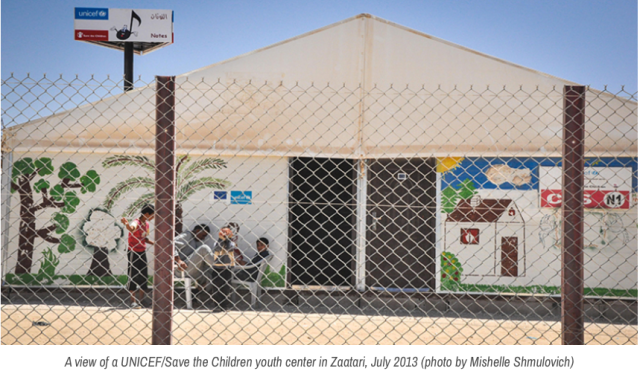Teachers all around the world face the challenge of providing a stimulating, relevant and engaging educational program that is going to provide the knowledge and skills necessary to try and prepare our students for life in the “real world”. How then does a teacher prepare a Syrian refugee child living in Za’atari for this? For many, their “real world” experiences have shattered any chance of the innocence of childhood. Many bear the scars – emotionally, psychologically and physically. So, how can a teacher make a difference? What educational facilities are available to them?
The children and families of Za’atari face enormous challenges as they attempt to rebuild their lives from within the confines of an indefinite future of a refugee camp. No set timeframe of how long they will be there. No confirmation of if they will ever be able to go home to Syria or will they be able to start a new life somewhere else? It is uncertainty on top of more uncertainty. An ongoing liminal space.
But, days and weeks and months pass. Children get older and as they do they are continuing to potentially miss out on opportunities which will help them now and in the future.
Although the Za’atari camp is away from the terrors of war, there is still a level of fear, particularly for girls moving about the camp. Their safety against attack and (or rape) is paramount and often this can result in girls being kept hostage of sorts within the confines of their small tent or caravan. However, so much of the evidence collated from around the world today shows that the education of girls is paramount to the overall increase in improvements to local communities and society in general.
- Reduction of child and maternal mortality
- Improvement of child nutrition and health
- Lower birth rates
- Enhancement of women’s domestic role and their political participation
- Improvement in their economic productivity and growth
- Protection of girls from HIV/AIDS, abuse and exploitation
“Girls’ education yields some of the highest returns of all development investments, yielding both private and social benefits that accrue to individuals, families, and society”. (Educating Girls Matters, n.d)
That urge to protect their children spreads to the boys as well, and many are restricted to staying nearby their families. However, progress is being made. Even with only 2% of international humanitarian aid being allocated to education, the numbers of children attending some type of formal education whilst living in Za’atari has increased. in 2013, a UNICEF report showed that attendance across all age groups was 51.6%. The figures from 2015 show an encouraging trend amongst the younger children, but a rapid dropoff without suitable upper secondary and/or tertiary options. Some feel that this is due to the perception that the degree with be worthless when they finally return home to Syria. More likely is the lack of any suitable upper secondary or tertiary options to pursue.
Image 1 (2015)
Many adults and children are involved in education to improve their knowledge and skills, but also to contribute to the community and help pass the time. A teacher in Za’atari said “I graduated from my law degree and I was working as a trainee in Syria”. When he was asked why he had chosen to become a teacher. “I wanted to share my education with others rather than keep it to myself,” he replied. “I’m happy to be able to give back to the children living in this camp.” (Save the Children, 2014)
The facilities of the education spaces in Za’atari are varied. Physically, spaces are split – often one area for girls, one for boys; one classroom session for boys and one session for girls. “In a camp where there is little to do it’s so important to have an outlet to keep healthy and busy. “We now go to bed early because we have something to look forward to the next day,” said a 16-year-old with a smile. “I used to go to sleep at 2am but now by 9pm I am already in bed because I have a long day of activities ahead of me.” (Save the Children, 2014)
Image 2 (2013)
Pleasingly, though, not all of the educational resources are as basic as one might assume. For example, Relief International runs a program which is designed to cover both the educational and psycho-social development of the children.
- A remedial education center in the camp which provides classes in Arabic, Math, Science and English for grades 1-11. The remedial classes enable the children to develop their skills and stimulate their participation in their daily environment.
- Classes for boys are provided in the morning as their formal education takes place in the afternoon and girls come to the center in the afternoon after their classes at the main school. There are four periods of 45 minutes including one for supervised recreational activities where students can enjoy competitive and team building activities, develop their imagination and learn to interact amicably with other students in an open space and a safe and environment. Most importantly, these activities promote a sense of normalcy by giving them the space, time and right to play as children.
- Each class has a teacher as well as a case manager who ensures the child attends the remedial education classes regularly, tracks the child’s educational progress and provides individual follow up. Their role is also to provide additional guidance, monitor children’s behavior and help identify and work with children who need further psycho-social support.
- Community mobilizers create a link between refugee families and the center, ensuring awareness about the services provided and information of how to access it, as well as the positive opportunities that extra educational support can bring.
- To increase the safety of the children, community mobilizers also accompany students between the Relief International center and meeting points in the camp and the main school.
- All teachers, case managers and community mobilizers are Syrians from the refugee camp. This creates understanding and trust between staff and children as they are familiar and have been through the similar experiences, whilst also providing employment to those living the camp.
- Other staff are Jordanian from the local town, which also provides employment for those in the host community
(Relief International, 2013. and n.d)
Upon further investigation, the motivation and desire to provide the most educationally relevant and engaging programs whilst still overseeing and managing the wellbeing of each child has commenced through the work of agencies such as UNICEF, Save the Children and Relief International, to name a few.
Perhaps the challenge now is how can these educational facilities and program models be made accessible for ALL refugee children. And furthermore, what steps are necessary to transform them into experiences that provide a comprehensive end-to-end educational model (pre-school through to Tertiary) which will be relevant and meaningful for life beyond Za’atari.
After all, that is the hope of so many refugees confined to living there.
Links
Image 1 (2015). Retrieved on October 15, 2015 from http://data.unhcr.org/syrianrefugees/settlement.php?id=176®ion=77&country=107. Direct link – Za’atari Camp CCFA; Education/Youth Factsheet
Image 2 (2015). Retrieved on October 15, 2015 from http://www.al-monitor.com/pulse/originals/2014/08/jordan-zaatari-schools-syrian-refugess.html



What a well written and well researched post. Some very good insights here.
LikeLike